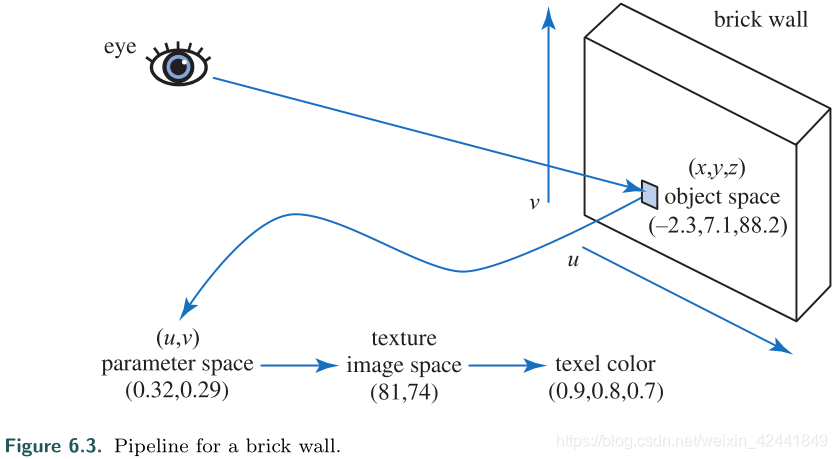“All it takes is for the rendered image to look right.”
—Jim Blinn
本章写得有些偷懒,是希望尽快跳到后面没有接触过的内容章节。
1 纹理映射管线


1.1 投影方程(The Projector Function)
常用的就是美术编辑(u,v)值,除此之外还有多种投影方式:

1.2 对应方程(The Corresponder Function)
对应方程转换纹理坐标到纹理坐标系的位置。它们在应用纹理到表面提供了灵活性。其中一个例子是利用API选择纹理的一部分来显示;
另一种类型是矩阵变换,可以应用到顶点和像素shader中。它可以移动,旋转,缩放,裁剪或者投影纹理到表面。
另一个类型的对应方程控制了纹理在超出[0,1]范围的应用方式,在DX中叫做“texture addressing mode.”,常用的类型如下:
- wrap (DirectX), repeat (OpenGL), or tile;
- mirror;
- clamp (DirectX) or clamp to edge (OpenGL);
-
border (DirectX) or clamp to border (OpenGL)

1.3 纹理值
返回纹理对应坐标下的像素RGB值(可包括alpha)。
2 图像纹理(Image Texturing)
2.1 放大
最常见的放大滤波技术是nearest neighbor和线性插值。还有一种叫做 cubic convolution的方法,它使用4×4或者5×5的像素根据权重求和,它可以得到更好的放大效果。但是硬件一般不直接支持这种算法,它可以在shader中实现。



2.2 缩小
依然有3种方法:nearest neighbor,线性插值以及mipmapping:

– Mipmapping
最流行的在纹理映射中反走样的方法是mipmapping。其中的一组图像叫做mipmap chain,如下图:

组成高质量mipmap的两个重要因素是滤波和gamma矫正。
– Summed-Area Table
另一个防止过渡模糊的方法是Summed-Area Table(SAT)


– Unconstrained Anisotropic Filtering
这个是目前图像硬件最长用的提升纹理滤波质量的方法。

2.3 体积纹理
使用 (u,v,w)的三维纹理数据。
2.4 Cube Maps
由6个面组成的纹理,后续第十章详解。
2.5 Texture Representation
对于在同一个应用中控制很多张纹理,有很多中方法来提升性能。2.6节介绍纹理压缩。19掌中介绍纹理流和转码。
为了应用批处理,使用更大的纹理 texture atlas。

2.6 纹理压缩

3 Procedural Texturing

还有很多其它procedural texture算法,可以参考书中原文。
4 纹理动画
可通过修改[u,v]值达到简单的动画,也可以通过变换矩阵达到复杂一些的效果。
5 Material Mapping
纹理的常用方法是改变材质的属性,来影响着色方程。

材质还可以有进一步的应用。可以同来控制flow以及pixel shader本身。两个或者更多有不同着色方程的材质,可以通过一个纹理应用到同一个表面(纹理中像素值指定使用哪个材质计算)。
6 Alpha Mapping
alpha值可以通过alpha混合或者测试来实现多种效果,比如植物,爆炸和远距离物体。
一种效果较decaling,比如你希望在茶壶上渲染一个花朵,你不希望贴上整张图,所以就可以通过alpha测试只贴花朵。

其他效果查看原书。
7 Bump Mapping
这一节描述一大家族的小细节表现技术,我们叫做凹凸贴图(Bump Mapping)。它们都是逐像素来调整,但是不添加几何细节。
物体的细节可以划分为3类: macro-features – 涵盖许多像素;meso-features – 几个像素;micro-features – 小于一个像素。
7.1 Blinn’s Methods
一种是在纹理的每个texel中保存两个值:Bu,Bv,它们对于法向量的变化情况;

另一种四使用heightfield膝盖表面法向量的方向。

7.2 Normal Mapping
bump mapping常用的方法是直接保存法向量贴图。


8 Parallax Mapping
法线贴图的纹理在于,它不偏移位置,并且不会相互阻挡。
视差贴图的关键思想是通过检查被发现的可视像素的高度,对像素中应该看到的内容进行有根据的猜测。

8.1 Parallax Occlusion Mapping

9 Textured Lights
纹理也可以用来改变光源的光照强度。

进一步阅读材料
Heckbert has written a good survey of the theory of texture mapping [690] and a more in-depth report on the topic [691]. Szirmay-Kalos and Umenhoffer [1731] have an excellent, thorough survey of parallax occlusion mapping and displacement methods. More information about normal representation can be found in the work by Cigolle etal. [269] and by Meyer et al. [1205].
The book Advanced Graphics Programming Using OpenGL [1192] has extensive coverage of various visualization techniques using texturing algorithms. For extensive coverage of three-dimensional procedural textures, see Texturing and Modeling: A Pro-cedural Approach [407]. The book Advanced Game Development with Programmable Graphics Hardware [1850] has many details about implementing parallax occlusion mapping techniques, as do Tatarchuk’s presentations [1742, 1743] and Szirmay-Kalos and Umenhoffer’s survey [1731].
For procedural texturing (and modeling), our favorite site on the Internet is Shader-toy. There are many worthwhile and fascinating procedural texturing functions on display, and you can easily modify any example and see the results.
Visit this book’s website,
realtimerendering.com
, for many other resources.